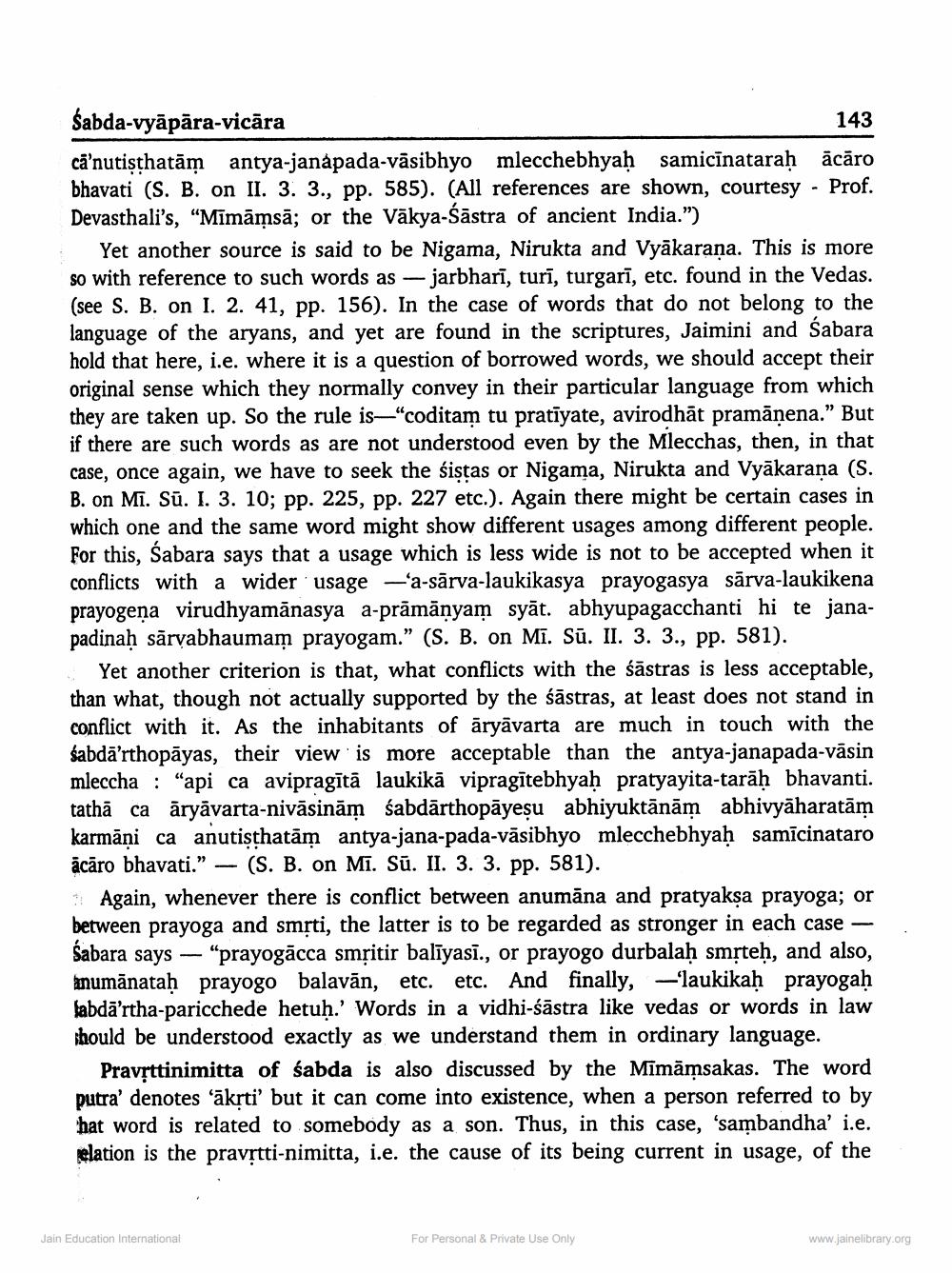________________
Sabda-vyāpāra-vicāra
143 ca'nutisthatām antya-janapada-väsibhyo mlecchebhyah samicīnatarah ācāro bhavati (S. B. on II. 3. 3., pp. 585). (All references are shown, courtesy - Prof. Devasthali's, “Mimāmsā; or the Vākya-Šāstra of ancient India.")
Yet another source is said to be Nigama, Nirukta and Vyākarana. This is more so with reference to such words as — jarbharī, turī, turgarī, etc. found in the Vedas. (see S. B. on I. 2. 41, pp. 156). In the case of words that do not belong to the language of the aryans, and yet are found in the scriptures, Jaimini and Sabara hold that here, i.e. where it is a question of borrowed words, we should accept their original sense which they normally convey in their particular language from which they are taken up. So the rule is—"coditam tu pratīyate, avirodhāt pramāṇena.” But if there are such words as are not understood even by the Mlecchas, then, in that case, once again, we have to seek the sistas or Nigama, Nirukta and Vyākarana (S. B. on Mi. Sū. I. 3. 10; pp. 225, pp. 227 etc.). Again there might be certain cases in which one and the same word might show different usages among different people. For this, Sabara says that a usage which is less wide is not to be accepted when it conflicts with a wider usage —a-sārva-laukikasya prayogasya sārva-laukikena prayogeņa virudhyamānasya a-prāmānyam syāt. abhyupagacchanti hi te janapadinaḥ sāryabhaumam prayogam." (S. B. on Mī. Sū. II. 3. 3., pp. 581).
Yet another criterion is that, what conflicts with the śāstras is less acceptable, than what, though not actually supported by the śāstras, at least does not stand in conflict with it. As the inhabitants of āryāvarta are much in touch with the śabdā’rthopāyas, their view is more acceptable than the antya-janapada-vāsin mleccha : "api ca avipragītā laukikā vipragītebhyaḥ pratyayita-tarāḥ bhavanti. tathāca āryāvarta-nivāsinām śabdārthopāyesu abhiyuktānām abhivyāharatām karmāņi ca anutişthatām antya-jana-pada-vāsibhyo mlecchebhyaḥ samīcinataro ācāro bhavati." - (S. B. on Mi. Sū. II. 3. 3. pp. 581).
Again, whenever there is conflict between anumāna and pratyaksa prayoga; or between prayoga and smrti, the latter is to be regarded as stronger in each case – śabara says — “prayogācca smțitir balīyasī., or prayogo durbalaḥ smộteḥ, and also, anumănatah prayogo balavān, etc. etc. And finally, -laukikah prayogah labdā’rtha-paricchede hetuh.' Words in a vidhi-śāstra like vedas or words in law should be understood exactly as we understand them in ordinary language.
Pravrttinimitta of sabda is also discussed by the Mīmāmsakas. The word putra' denotes 'ākrti' but it can come into existence, when a person referred to by hat word is related to somebody as a son. Thus, in this case, 'sambandha' i.e. relation is the pravrtti-nimitta, i.e. the cause of its being current in usage, of the
Jain Education International
For Personal & Private Use Only
www.jainelibrary.org




